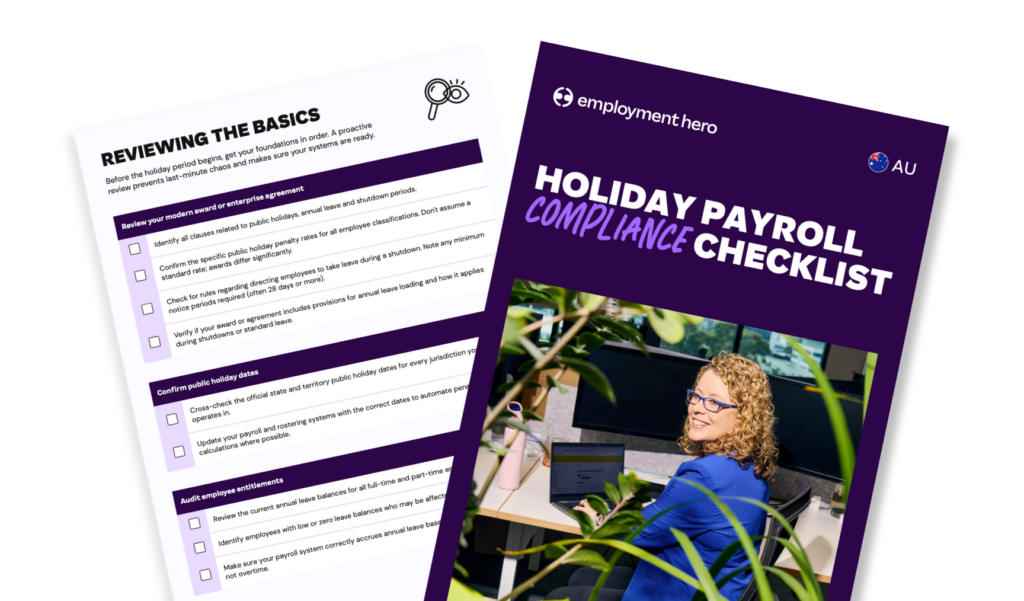Holiday payroll checklist for employers
Published
Holiday payroll checklist for employers
The festive season should be a time for everyone to recharge, but for many businesses, this time of year brings a wave of payroll headaches. Managing public holidays, leave entitlements and shutdown periods can quickly leave even the most experienced leaders feeling overwhelmed.
During the holidays, the stakes are high. You need to perfectly balance employee requests, business continuity and the avalanche of payroll and legal obligations. And if you get it wrong, it exposes you to compliance risks and unhappy employees.
That’s why we’ve created this holiday payroll checklist. It covers everything you need to check for a smooth holiday period.
What does this payroll checklist include?
In this checklist, you’ll find:
- The basics you need to know
- Managing leave and shutdowns
- Calculating pay and penalty rates
- Final payroll and record-keeping

Employment contracts and awards
Before you start calculating holiday pay, you need to be clear on the basics. Employment contracts and modern awards form the foundation of the employment relationship.
You must review each employee’s award or agreement to understand the specific rules that apply. Misinterpreting these can lead to significant underpayments.
Using powerful software that can automatically interpret modern awards automates this process, removing the question marks keeping your people paid correctly every time.
Public holiday pay rates
Public holidays often attract penalty rates. The exact rate depends on the specific award or enterprise agreement covering your employees, with some awards requiring you to pay double time, double time and a half or even more.
You also need to consider minimum engagement periods. If you require employees to work on a public holiday, their award might specify they must be paid for a minimum number of hours, even if they work for less. Double-check the penalty rates applicable to your team to ensure everyone receives their correct pay.
Overtime and additional hours
For many businesses, the lead-up to the festive season is a peak period, often requiring employees to work additional hours. It’s crucial to understand what your award defines as overtime and the corresponding pay rates.
Overtime will be defined in your award or agreement. Don’t fall into the trap of assuming that all extra hours are paid at a standard flat rate.
Record keeping
Under the Fair Work Act, maintaining accurate and up-to-date employee records is a legal requirement. Your record keeping must detail hours worked, pay rates applied, leave taken/accrued and superannuation contributions.
These records must be readily available for inspection and kept for a period of seven years.

Can employers require staff to take leave during a shutdown?
As you head into the end-of-year period, it’s important to understand how rules and entitlements change depending on whether your business is operating, shutting down or reducing staff.
If you plan a shutdown and are directing employees to take annual leave, Fair Work states that the direction must be:
- Reasonable
- In writing
- Comply with the relevant award or enterprise agreement
If your modern award or agreement doesn’t include shutdown clauses, you can’t force them to take annual leave, but you can arrange it by mutual agreement. If they don’t have enough annual leave accrued you can agree that they can take annual leave in advance of it accruing (if their modern award allows this) or agreeing that they will take unpaid leave.
Employees can’t be forced to take unpaid leave in any circumstances.
Award-free employees can be required to take annual leave during a shutdown, so long as the requirement is reasonable. Similarly to award-covered employees, they can only take unpaid leave by agreement. This can’t be forced upon them.
If your business is working over the period (e.g. retail or hospitality), then you may ask employees to work overtime or on public holidays, but again, it must be a reasonable request, considering their notice, their role and their personal commitments.
How should you communicate a holiday shutdown to staff?
Clear, timely communication is the secret to a stress-free holiday shutdown. Employees need to know well in advance when your business will be closing, how long the shutdown will last and how it will affect their pay and leave. Leaving things vague or announcing too late can cause unnecessary confusion, frustration and even compliance issues.
Start by providing official written notice of the shutdown as early as possible, ideally well before the end-of-year rush. Most modern awards require a minimum notice period (often four weeks) before a business can direct employees to take annual leave, so it’s essential to check the relevant award or enterprise agreement and plan accordingly.
Your communication should clearly outline:
- The exact dates of the shutdown period and when normal operations will resume.
- Whether employees are required to take annual leave, and if so, how that will be processed.
- What options are available for employees who don’t have enough leave accrued, such as agreeing to take leave without pay or annual leave in advance or working alternative duties during the shutdown.
- Who they can contact (for example, HR or payroll) if they have questions about their entitlements.
You can share this message via email, an internal announcement or your HR and payroll platform. Anywhere your team is most likely to see it.

Do businesses need to pay staff during a shutdown?
Payment during a shutdown depends on the employee’s status and their entitlements.
Full-time and part-time employees: If you ask them to take annual leave, you must pay them for their accrued annual leave during the shutdown. If they run out of paid leave, they may take unpaid leave, but only by agreement. Other options are providing them with annual leave in advance of it accruing or having them do alternative duties during the shutdown.
Casual employees: Casuals are not entitled to paid annual leave. They are not paid for the shutdown period unless they are rostered to work.
Contractors: Independent contractors are not employees and are not entitled to paid leave. Their payment is based on the terms of their contract for services.
What payments are required during annual leave?
When an employee takes annual leave, they’re entitled to receive their base rate of pay for their ordinary hours of work. This is the same rate they’d earn if they were working. This includes any regular allowances, loadings or penalties that are part of their usual pay, but it doesn’t include overtime, bonuses or commission.
Many awards and enterprise agreements also require an annual leave loading, typically 17.5%, to recognise that employees may miss out on penalty rates or overtime while on leave. Employers should always check the applicable award or agreement to confirm the correct rate.
The most important part here is making sure that all payments during leave, whether it’s ordinary, loaded or by agreement, comply with the Fair Work Act and any relevant awards or agreements.
Common holiday payroll mistakes to avoid
Even with the best intentions, you’re still human and mistakes can still happen. Here’s some common mistakes to look out for:
Underpaying public holiday penalty rates
Misinterpreting modern awards or failing to apply the correct penalty rates for public holiday work is one of the most frequent holiday payroll errors. Each award has specific rates for public holidays and these vary depending on the industry, role and employment type.
Getting this wrong can lead to underpayments, back pay obligations and compliance issues. Always double-check your employees’ classifications and refer to the applicable modern award before processing pay.
Miscalculating annual leave accruals
The holiday period often coincides with business shutdowns or multiple employees taking leave at once.
Miscalculating how much leave an employee has accrued can result in overpayments or underpayments during this time. Using an automated system that accurately tracks leave entitlements and accruals based on actual hours worked can help you avoid costly mistakes.
Remember that public holidays are separate from annual leave. If a public holiday falls during an annual leave period, it does not reduce an employee’s annual leave balance.
Ignoring minimum engagement periods
Many awards include rules about minimum engagement periods i.e. the minimum number of hours an employee must be paid for when rostered on a public holiday. This could be 3 or 4 hours, but is dependent on the modern award.
Poor record keeping
Inadequate payroll records are one of the most common reasons employers face compliance challenges. Failing to keep accurate records of hours worked, public holiday pay or leave taken can make it difficult to demonstrate compliance if audited by Fair Work. Always keep detailed records and ensure they’re easily accessible for at least seven years, as required by law.
Automating your payroll is one of the most powerful ways to avoid these errors. To see the impact it can have, explore the power of automated payroll.
Download the holiday payroll checklist
Don’t let payroll stress ruin your holiday season. Arm yourself with the right tools and knowledge to manage your holiday payroll with ease. If you’d like to take the stress out of holiday payroll completely, take a look at our managed payroll service.
The information in this checklist is current as at 9 October 2025, and has been prepared by Employment Hero Pty Ltd (ABN 11 160 047 709) and its related bodies corporate (Employment Hero). The content is general information only, is provided in good faith to assist employers and their employees, and should not be relied on as professional advice. Some information is based on data supplied by third parties. While such data is believed to be accurate, it has not been independently verified and no warranties are given that it is complete, accurate, up to date or fit for the purpose for which it is required. Employment Hero does not accept responsibility for any inaccuracy in such data and is not liable for any loss or damages arising directly or indirectly as a result of reliance on, use of or inability to use any information provided in this checklist. You should undertake your own research and seek professional advice before making any decisions or relying on the information in this checklist.
Register for the template
Related Resources
-
 Read more: EOFY Important Dates Calendar
Read more: EOFY Important Dates CalendarEOFY Important Dates Calendar
Gearing up for EOFY? To help you prepare, we’ve put together a calendar of important dates to support you through…
























